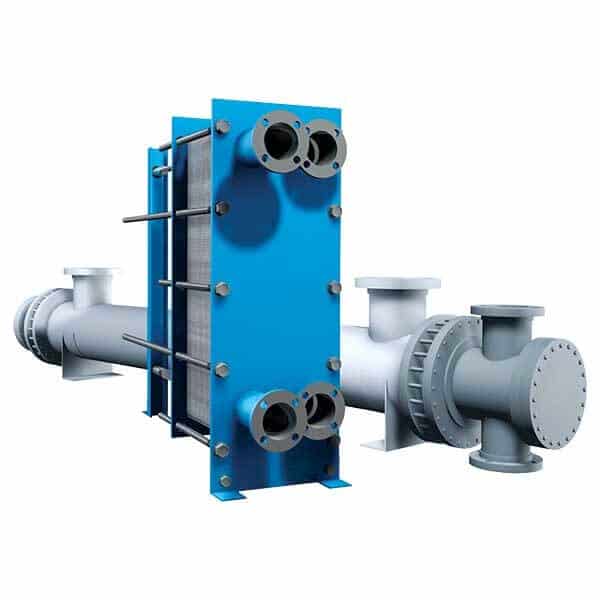You might be surprised, what an enormous benefit a senior executive or even a CEO, might extract by evaluating such a system-embedded or an integrated component as a Heat Exchanger.
In fact, the types of heat exchangers installed in your facilities, have a significant impact – not only on multiple cost factors related to overheads, but also on less tangible factors such as product output quality and uniformity and the comfort of the operating staff and their productivity levels.
If your facility uses today 20th century heat exchange technology and engineering, you have now the opportunity to reduce maintenance costs, retrieve wasted heat and emission energies, improve command and control and increase your production capacity, while occupying a much smaller space – by applying novel and advanced 21st century Plate Heat Exchangers technology and engineering in a variety of manufacturing and process applications.
All heat exchangers transfer heat energy between two or more different fluids, that flow in channels. These channels are over time subject to a phenomenon of severe narrowing caused by scale sediments and fouling. These are chemical and biological contaminants of various kinds that exist in these fluids.
The narrowing of internal channels in the heat exchanger, causes a steep drop in its performance, which significantly increases your fuel and electricity consumption – and thus your production costs.
If your facility uses 20th century heat exchanger technology, you might suffer from steeper fuel and electricity bills plus the burden of more frequent cleaning, spare parts and maintenance expenses, than with novel 21st century heat exchanger technology and engineering.
Why? Because the design of the fluids flow in the novel and advanced heat exchanger technology and engineering produce a turbulence level, which immediately promotes higher heat transfer between channels and at the same time these turbulence levels produce a natural effect of self-cleaning, which keeps the heat exchanger’s surfaces clean and free-flowing for a long time.

Plate and “Shell & Tube” heat exchangers of the equivalent calculated capacity, are supposed to transfer equal amount of energy in performing their task, whether it’ll be heating or cooling. That assuming that you are operating your thermal systems at an optimal and stable load all the time. However, this is not the case in real life.
The figures don’t lie! Your engineers will surely be able to explain why this is so, and a downsized model could exactly demonstrate the savings you are able to achieve at different loads.
When servicing is due, it turns out that “Shell & Tube” heat exchanger servicing is in fact more labor-intensive than a plate heat exchanger servicing. Its lengthy piping doubles the length and dimension of the heat exchanger, along with the need for specialized equipment and staff required.
The strong turbulence levels created in the fluids flow inside the plate heat exchanger, allow internal self-cleaning during the normal operation of Plate Heat Exchanger.
These strong turbulence levels that improve plate heat exchanger performance, help also dissolve and remove fouling without the need to stop and to dismantle the heat exchanger at all.
If the heat exchanger has to be dismantled, the heat transfer surfaces are fully visible and fully available for physical cleaning, or in the case of our “Plate & Shell” models, they can be chemically cleaned by cleaning fluid circulation.
In the models with Removable Core shell side can be also cleaned mechanically including cleaning between the assembled plates.

Your thermal systems, whether it is HVAC or any manufacturing process, produce a low-grade heat energy byproduct. This energy is emitted as “waste” and is dissipated.
Using old heat exchanger technology, one might consider these heat streams as “waste”, which it is not economically feasible to try to capture and recycle it. This is because these old heat exchange technologies are ineffective for these tasks. One does not need come to terms with shedding this by-product low-grade heat energy to the sewer – along with the precious energy it took to produce that heat in the first place.
Old heat exchange technology is unable to perform such a task effectively, capable of capturing only a tiny fraction of these emitted heat streams that advanced heat exchanger technology is able to capture, being used for this task.
This is emanating views about the economic deficiency in utilizing this low-grade heat energy by-product, by using old heat exchanger technology. You might need to provide additional energy, in order to perform what the recovered heat energy could have done instead.

We meet Heat Exchangers in the buildings as evaporators and condensers in chillers, as circuit dividers for Cooling Towers, for heating systems, for special end user applications, as, for example, High Rise Buildings Pressure Breakers or division Ultra-Pure Water circuits from Main Chilled Water Circuit of the building. In heating systems heat exchangers divide Boiler or Heat Pumps from end user’s potable water circuits.
As a “Rule of Thumb” for any cooling system based on Mechanical Vapor Compression Cycle one degree Celsius is responsible for 3% of cycle efficiency, more practically – for 3% of the electricity bill of the end user. More efficient heat exchanger using the modern heat transfer technology achievements provides lower temperature and saves energy. Properly designed heat exchanger can save to the end user its whole cost within only one year. And, vice versa, improperly selected equipment costs extra money to the end user during decades of operation.
Click here for more information about our heat exchangers >>
Click here to get genuine impressions from projects we have carried out >>
